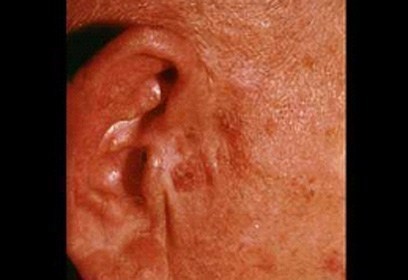As summer approaches, it’s a good time to take a good look at your skin, especially since 20% percent of Americans will develop skin cancer in their lifetime, according to the American Academy of Dermatology (AAD).
Anyone can get skin cancer. People with fair skin as well as men over the age of 50 are at a higher risk than the general population. “When my dad died of melanoma at 69, it was a huge wake-up call for me to take care of my skin,” says Geri Brin, founder of FabOverFifty.com. “Now, I always make sure my family and I have our yearly skin checks, or go to the dermatologist in-between if I see something new pop up. I encourage all women to keep an eye on their skin and their husbands’ skin, who may have been less inclined to use sunscreen over the decades.”

Here’s what you should know about the four most common types of skin cancer and how you can reduce your risk:
 ● Actinic Keratoses (AK) are dry, scaly patches or spots which are precancerous growths. AK is generally found on fair-skinned people, following decades of sun exposure, especially on their head, neck, hands and forearms.. AK usually starts appearing after a person turns 40, and can develop into a more serious type of skin cancer, called squamous cell carcinoma, if left untreated.
● Actinic Keratoses (AK) are dry, scaly patches or spots which are precancerous growths. AK is generally found on fair-skinned people, following decades of sun exposure, especially on their head, neck, hands and forearms.. AK usually starts appearing after a person turns 40, and can develop into a more serious type of skin cancer, called squamous cell carcinoma, if left untreated.![]()
 ● Basal cell carcinoma (BCC) is the most common type of skin cancer and looks like a flesh-colored, pearl-like bump or a pinkish patch of skin. “BCC can invade the surrounding tissue and grow into the nerves and bones, causing damage and disfigurement,” according to the AAD.
● Basal cell carcinoma (BCC) is the most common type of skin cancer and looks like a flesh-colored, pearl-like bump or a pinkish patch of skin. “BCC can invade the surrounding tissue and grow into the nerves and bones, causing damage and disfigurement,” according to the AAD.![]()
 ● Squamous cell carcinoma (SCC) appears as a red firm bump, scaly patch, or a sore that heals and then re-opens. It can also grow deep in the skin, causing damage and disfigurement. Early diagnosis is key, before the cancerous cells spread to other parts of the body.
● Squamous cell carcinoma (SCC) appears as a red firm bump, scaly patch, or a sore that heals and then re-opens. It can also grow deep in the skin, causing damage and disfigurement. Early diagnosis is key, before the cancerous cells spread to other parts of the body.![]()
 ●Melanoma is the deadliest form of skin cancer, and frequently develops in a mole or suddenly appears as a new dark spot on the skin. Learn the ABCDE warning signs for melanoma by visiting the AAD’s site here.
●Melanoma is the deadliest form of skin cancer, and frequently develops in a mole or suddenly appears as a new dark spot on the skin. Learn the ABCDE warning signs for melanoma by visiting the AAD’s site here.![]()
There are simple steps you can take to protect your skin from the sun and reduce your risk of skin cancer. The AAD recommends seeking shade whenever possible, wearing sun-protective clothing, and applying a water-resistant broad-spectrum sunscreen with an SPF of 30 or higher.
DIAGNOSIS & TREATMENT
More than 8,500 people in the U.S. are diagnosed with skin cancer every day, and one person dies from melanoma every hour.
“Given my family’s history with skin cancer, I’m always on the lookout for new moles and bumps,” says Geri. “That being said, dermatologists can see things I may not notice, so I always visit at least once a year for a skin check. AAD is currently offering free SPOTme® Skin Cancer screenings and through the summer, so make sure you and your family go find a screening as soon as possible. Don’t wait until it’s too late!”
![]()
Skin cancer is treatable if caught early. As part of the AAD’s “Looking Good in 2016” campaign, they want you to make sure your skin is “looking good” by checking it for the signs of skin cancer. Their new “Looking Good” PSA uses humor to encourage men over 50 to regularly check their skin and find a partner to help. If you see any new or suspicious spot on your or your loved ones’ skin, make an appointment to see a board-certified dermatologist. Find out here where you can get a free SPOTme® Skin Cancer screening in your area. Visit the AAD’s site here and let them know what motivates you to check your skin for the signs of skin cancer.
This is a sponsored conversation written by me on behalf of American Academy of Dermatology. The opinions and text are all mine.


0 Responses to “What You Should Know About Skin Cancer”
April Cook says:
My sister was recently diagnosed with skin cancer, and it had made me more aware of my own skin. I didn’t realize that there were multiple types of skin cancer. Is is common to have more than one type of cancer at the same time? I think I’ll follow your suggestion and have my dermatologist check things out regularly to make sure that I’m ok. Thanks for this information! http://www.strnotderm.com/general-dermatology